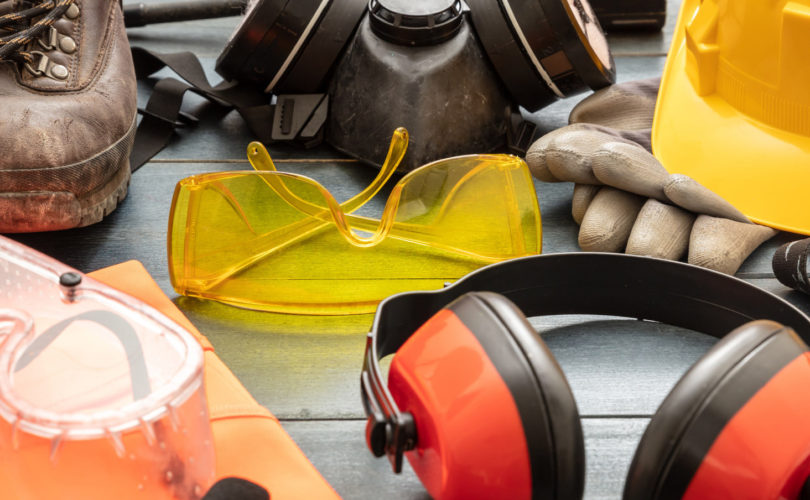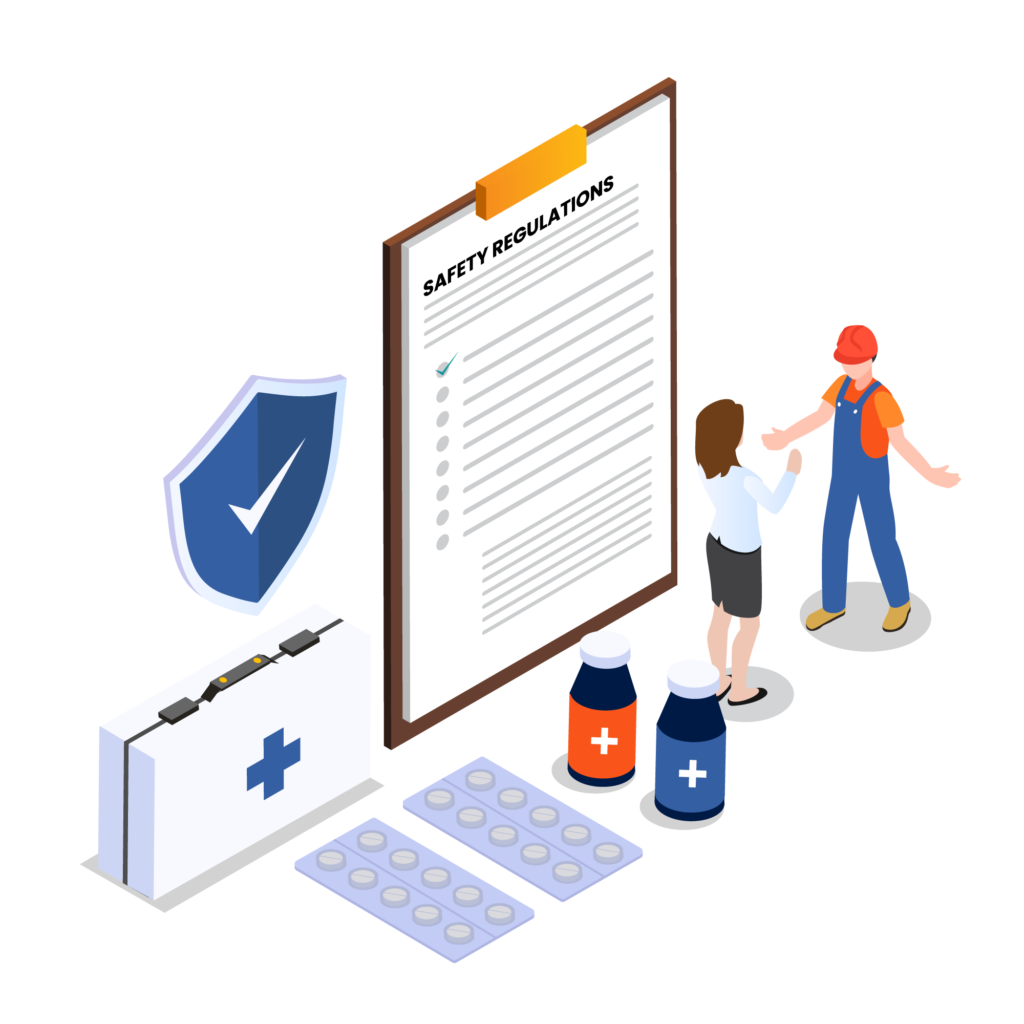ANSI and OSHA
ANSI and OSHA are two organizations that have created many of the safety standards for workplaces in the United States, including first aid requirements. The two are completely separate entities that work together in order to create functional standards and requirements. ANSI stands for The American National Standards Institution. OSHA stands for The Occupational Safety and Health Administration. Where they differ is that ANSI is a non-profit organization that helps develop voluntary standards for other organizations, while OSHA is a section of the United States Department of Labor that creates and enforces regulations.
What this means is that ANSI works as a “neutral venue for coordination of standards-based solutions…to initiate collaborative standardization activities that respond to national priorities,” which dictate specific OSHA regulations.
For a simple example, here’s the basic flow of safety regulations: Construction workers suffer a high rate of eye injuries, so OSHA mandates that all construction companies must provide and require their workers to wear safety glasses. Then, members of ANSI familiar with different brands of safety glasses and knowledge of construction work collaborate to create a standard for style and materials that would optimally protect a construction worker. ANSI then delivers this information to OSHA, which leads to OSHA requiring construction companies to only provide and only allow the use of the safety glasses that ANSI has deemed most appropriate.
ANSI or OSHA?
In short, OSHA creates and enforces regulations while ANSI helps specify the regulations, so companies are unable to subvert the regulations to save money (i.e., spending less money on lower quality safety glasses). Because of how much the two interact, and the way they interact, everything that is OSHA compliant is also ANSI compliant, but not everything that is ANSI compliant is OSHA compliant. For more information on ANSI-compliant products, check out our ANSI Fanny Pack.
In order to properly explain this, we will look at regulations for first aid kits. OSHA only requires “medical and first aid personnel and supplies commensurate with the hazards of the workplace. The details of a workplace medical and first aid program are dependent on the circumstances of each workplace and employer”. This means industries such as construction, maritime, electrical, commercial driving, and logging must have first aid supplies, defined by ANSI, kelly forceps while an office which only has staplers its most dangerous item doesn’t.
ANSI has created a list of first aid supplies that are required for the company/office to be recognized as ANSI compliant. Since ANSI is not a governing body and their regulations are voluntary, companies cannot be penalized for failing to comply.
Why Follow ANSI Compliance?
Being ANSI compliant allows companies to become part of ANSI. This provides them with benefits listed on their website, such as being able to provide suggestions to standards, among many other benefits. However, one benefit that is not provided directly by ANSI is employee satisfaction. Even for people who are not working in hazardous situations, knowing that your company is following guidelines that help protect you is comforting, especially if they are voluntarily part of ANSI.
ANSI developed health and safety standards for both consumers and the workplace environment. ANSI has established a set of minimum requirements for workplace first aid kits and their contents. Their standards take into consideration that each workplace has a different variety of onsite hazards that can occur. ANSI’s 2015 edition includes two first aid kits that are differentiated based on the amount and type of first aid equipment included in each kit. The contents of the kits were determined based on reviews of workplace accidents that required first aid treatment.
Kit Requirements
Each class has a minimum required fill to allow them to be classified as ANSI Compliant. If you buy a cheap first aid kit and it does NOT meet the below requirements, then it is not considered ANSI Compliant. The most recent ANSI standards include Class A and Class B kits.
CLASS A: Used for minor and common workplace injuries including things like cuts, scrapes, burns, etc.
CLASS B: Catered towards a more high-risk work environment. There are more supplies and a greater quantity of individual supplies to help treat injuries in a more complex work environment.
ANSI/ISEA Z308.1-2015 Standard:
Required Minimum Fill in ANSI/ISEA Z308.1-2015 Class A First Aid Kits:
- 16 – Adhesive Bandages, 1″ x 3″
- 1 – Adhesive Tape 2.5 yd
- 10 – Antibiotic Treatment Application, 1/57 oz
- 10 – Antiseptic Applications 1/57 oz
- 1 – Breathing Barrier
- 1 – Burn Dressing, gel soaked, 4″ x 4
- 10 – Burn Treatment, 1/32 oz
- 1 – Cold Pack
- 2 – Eye Covering
- 1 – Eye Wash, 1 oz.
- 1 – First Aid Guide
- 6 – Hand Sanitizer, 0.9g
- 2 – Pair Exam Gloves
- 1 – Roller Bandage, 2″ x 4 yds
- 1 – Scissors
- 2 – Sterile Pad, 3″ x 3″
- 2 – Trauma Pad, 5″ x 9″
- 1 – Triangular Bandage, 40″ x 40″ x 56″
Required Minimum Fill in ANSI/ISEA Z308.1-2015 Class B First Aid Kits:
- 50 – Adhesive Bandages, 1″ x 3″
- 2 – Adhesive Tape 2.5 yd
- 25 – Antibiotic Treatment Application, 1/57 oz
- 50 – Antiseptic Applications 1/57 oz
- 1 – Breathing Barrier
- 2 – Burn Dressing, gel soaked, 4″ x 4
- 25 – Burn Treatment, 1/32 oz
- 2 – Cold Pack
- 2 – Eye Covering
- 1 – Eye Wash, 4 oz.
- 1 – First Aid Guide
- 10 – Hand Sanitizer, 0.9g
- 4 – Pair Exam Gloves
- 2 – Roller Bandage, 2″ x 4 yds
- 1 – Roller Bandage, 4″ x 4 yds
- 1 – Scissors
- 1 – Splint – min 4″ x 24″
- 4 – Sterile Pad, 3″ x 3″
- 1 – Tourniquet
- 4 – Trauma Pad, 5″ x 9″
- 2 – Triangular Bandage, 40″ x 40″ x 56″
Closing Thoughts
Every work place should have at least one first aid kit to treat any on-site injuries. First aid kits are only considered compliant if they are maintained regularly. Supplies have expiration dates, therefore, kits should be frequently inspected and used or expired products should be replaced.




